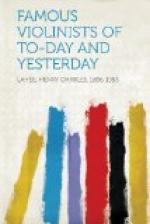In 1879 she made a tour to Australia, and again in 1894.
In 1895 she was in South Africa, and achieved great triumphs in Cape Town, besides giving concerts at such out-of-the-way places as Bloemfontein. She has probably travelled farther than any other violin virtuosa.
For the past few years she has lived in New York, and has practically retired from the concert stage.
Teresina Tua, who was well known in the United States about 1887, was born at Turin in 1867. As in the case of Wilhelmina Neruda and of Camilla Urso, her father was a musician, and she received her early musical instruction from him. Her first appearance in public was made at the age of seven, and up to that time she had received no instruction, except that given her by her father. During her first tour she played at Nice, where a wealthy Russian lady, Madame Rosen, became interested in her, and provided the means to go to Paris, where she was placed under Massart.
In 1880 Signorina Tua won the first prize for violin playing at the Paris Conservatoire, and the following year made a concert tour which extended through France and Spain to Italy. In 1882 she appeared in Vienna, and in 1883 in London, where she played at the Crystal Palace. Wherever she went people of wealth and distinction showed the greatest interest in her, and when she came to America in 1887 she appeared laden with jewelry given her by royalty. Her list of jewels was given in the journals of that day,—“a miniature violin and bow ablaze with diamonds, given by the Prince and Princess of Wales; a double star with a solitaire pearl in the centre, and each point tipped with pearls, from Queen Margherita of Italy.” Besides these, there were diamonds from the Queen of Spain and from the Empress of Russia and sundry grand duchesses. No lady violinist ever appeared before an American audience more gorgeously arrayed. “Fastened all over the bodice of her soft white woollen gown she wore these sparkling jewels, and in her hair were two or three diamond stars,” said the account in Dwight’s Journal of Music. Yet with all this the criticisms of her playing were somewhat lukewarm. The expectation of the people had been wrought up to an unreasonable pitch, and Signorina Tua, while she was acknowledged to be an excellent and charming violinist, was not considered great. After a time, however, as she became better known, she grew in popular estimation, and before she left America she had hosts of admirers.
On returning to Europe she made another tour, but shortly afterwards she married Count Franchi Verney della Valetta, a distinguished Italian critic, and retired into private life, though from time to time she was heard in concerts in Italy.
In 1897 she was again on the concert stage, and played at St. James’s Hall, London, after an absence of eight years, and it was considered that her playing had gained in breadth, while her technique was as perfect as ever.




